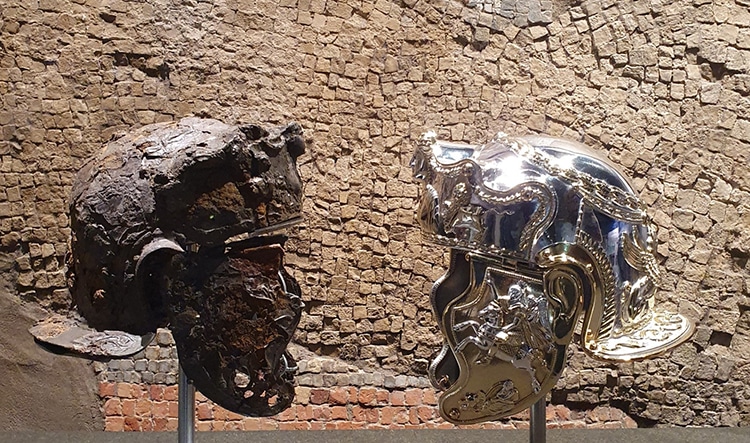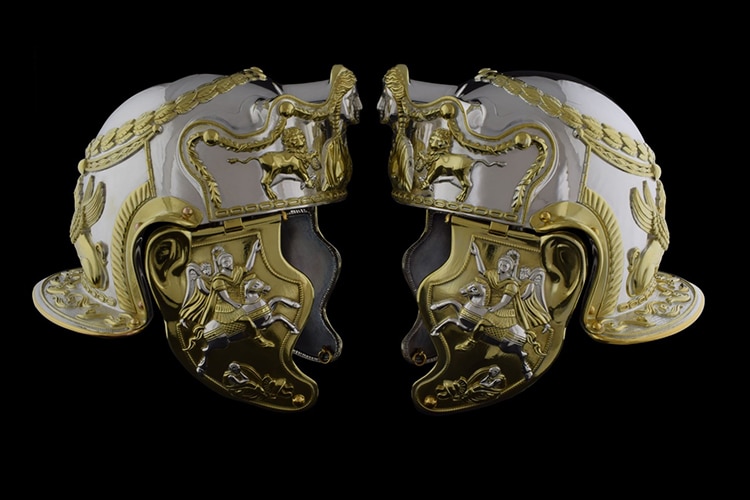
The Hallaton Helmet faces its own modern replica. (Photo: Leicestershire County Council Museums)
Before the Romans arrived on what is now English soil in 43 CE, the United Kingdom was filled with local tribal kingdoms. The powerful empire successfully conquered the island despite resistance, bringing the new province of Britannia into the imperial fold. About 40,000 soldiers facilitated this conquest—a mix of foot soldiers and cavalry, high command, and lowly troops. This invasion changed the course of British history demographically, politically, and economically. It also left behind relics of a changing world. Among these is the Hallaton Treasure, discovered in Leicestershire, England. Most prominent in this Iron Age trove is a helmet and seven cheekpieces of iron and silver, ornately designed with Roman-style figures. Finally restored and painstakingly replicted, the helmet is now on display at the Harborough Museum.
The helmet was discovered buried in 2001 and initial identification of the metallic, rusted mass was slow. The painstaking ultra-delicate restoration was conducted at the British Museum to bring the helmet to its present state of about 80 percent restoration. The helmet is crafted from iron and dates to the first century CE. It is shaped with reliefs of laurels and lions, as well as a goddess on the forehead. On one of the cheekpieces discovered with the main helmet, a Roman emperor and a winged Victory glide victorious over the conquered.
“It is one of a handful of silver-plated helmets ever found in Europe,” Helen Sharp of the Leicestershire County Council museums tells the BBC. “It is extremely high-status; it would have been worn by an extremely high-status officer, and it just shows how well connected the Leicester area was at the time.”
The magnificent piece was not lost but likely buried purposefully in a ritual. The Hallaton Fieldwork group of volunteers and the University of Leicester Archaeological Services (ULAS) discovered over 5,000 coins nearby, buried in troves that seem to be offerings at a sacred site. The helmet was found with coins and pig remains. Iron Age Britons often used pork for special feasts.
While the helmet’s reason for burial is unknown, its presence within an area that functioned as a shrine even prior to the turbulent time of Roman conquest is significant. “Archaeologists believe that the site is a type of open-air shrine that is the first of its kind to have been discovered in the UK. It was located on a hilltop and was probably enclosed by a ditch with a palisade to one side,” the Harborough Museum writes.
Visitors are now able to view the restored helmet at the museum, on display with cheekpieces and other aspects of the treasure. Two craftsmen have also replicated the helmet. Rajesh Gogna of De Montfort University used CAD 3D-design technology to create a resin model, which he then covered in silver. One copy is on display with the original at Harborough Museum, while another was given to Hallaton Museum. Archeologist Francesco Galluccio also made a replica with traditional metalworking techniques. Both replicas allow viewers a glimpse at the original glory of the helmet, in order to understand how remarkable find it is.
This ancient Romain helmet discovered in the United Kingdom is rich in detail and magnificent in craftsmanship.

The helmet was found with a series of contemporaneous cheekpieces. (Photo: Leicestershire County Council Museums)
Part of the remarkable Hallaton Treasure, the helmet has recently been restored, and replicas have been produced, bringing its true beauty to light.

3D technology helped create the replica resin helmet produced by Rajesh Gogna. (Photo: Leicestershire County Council Museums)
h/t: [Smithsonian Magazine]
Related Articles:
7,000-Year-Old Canoes Discovered Near Rome Are Oldest Ever Found in Mediterranean
New Well-Preserved Paintings Discovered at Pompeii Amid Ongoing Excavations
Water Worker Accidentally Discovers 2,500-Year-Old Gold Torc Necklaces in Spain
Incredibly Rare Ceramic Head Helps Uncover Previously Unknown Roman Settlement in Britain/a>
